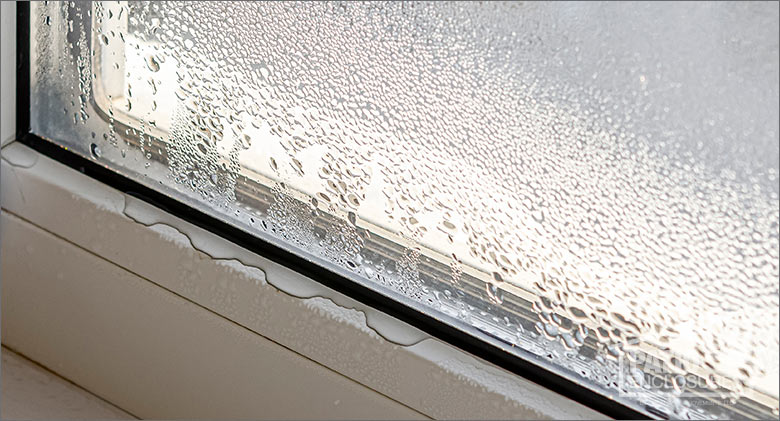
In this post, you will learn…
- What causes windows to fog up
- How to prevent your sunroom windows from fogging
- How to know it’s time to replace foggy sunroom windows
Your sunroom is the perfect place to unwind and enjoy the beautiful scenery outside. But it can be hard to relax when your view is obstructed by fog or condensation on your windows. Foggy windows are frustrating and can be a tough problem to fix. Learn more about why your sunroom windows fog up, how you can prevent window condensation, and how to know when it’s time to replace damaged, foggy windows.

Why Do Windows Fog Up?
First, it is important to note that there are two types of window fog: fog from condensation and fog from window seal failure. These types of fog are caused by different circumstances.
Fog from Window Condensation
Condensation can occur on the glass on both the interior and exterior of windows. Condensation on the inside of your windows occurs when the inside of your house is colder than it is outside. Condensation on the outside of your windows is the opposite and occurs when it is colder outside than it is inside your home.
But fog from condensation doesn’t mean there is anything wrong with your windows. Condensation on windows is an indication of excess humidity, similar to how your bathroom mirror fogs up after a hot shower. Your mirror doesn’t cause condensation, and neither do your windows.
Indoor Window Condensation
In warmer months, indoor condensation occurs when warm, humid air meets a cold surface. The air around us contains moisture, and the warmer the air is, the more moisture it can hold. As air cools, it contracts, and its moisture condenses. When the temperature lowers, the first place condensation will appear is on your windows because they are the coldest surface in your house. During colder months, indoor air is much warmer and holds more moisture than outdoor air, which is colder and dry. Warm, humid indoor air cools and contracts, and as it meets the cooler windows, the moisture condenses on the glass.
How to Prevent and Stop Indoor Window Condensation in Your Sunroom
It’s important to prevent excess moisture in your home for several reasons. First, mold and mildew grow in moist organic material such as wood, plaster, and certain types of insulation. Additionally, humid indoor air can actually cause damage to your home. Because humid indoor air is often under higher pressure than outdoor air, it’s constantly pushing its way outward through wood, plaster, concrete, and insulation. This can cause several problems, including deteriorated insulation, peeling paint, stains on ceilings and walls, rotting floors, or foundation damage.
To prevent excess moisture and stop window condensation and other issues:
- Make sure your home has proper ventilation in humid places like the bathroom, the laundry room, and the kitchen. Install exhaust fans that vent to the outdoors or crack a window if necessary.
- Control the moisture levels in your home with a dehumidifier.
Outdoor Window Condensation
Condensation on the outside of your windows doesn’t mean you have a defective product. Exterior condensation is just dew that has collected on the glass. This usually happens between cool nights and warm days and occurs when water vapor encounters a surface that has a temperature below the dew point. Actually, exterior condensation is a sign of energy efficiency and indicates that the outside windowpane is insulated from the warmth of your home.

Fog from Window Seal Failure
Many sunroom windows have an insulated glass unit, or an IGU, that is made up of two panes of glass with an inner and outer seal and spacer. This insulated air space between the two panes of glass reduces heat loss and increases the energy efficiency of the room. These types of windows are extremely popular due to their quality and ability to stand up to the elements and everyday use. Over time, though, the seals around the IGU can fail and fog can occur between the glass panels. Window seal failure can be caused by:
Water damage — After heavy rain or a flood, outside window seals are vulnerable to standing water, which can deteriorate seals.
Age — After decades of withstanding the opening and closing of the window as well as harsh weather, window seals tend to decline.
Excessive heat — Constant, direct sunlight causes window seals to expand and contract throughout the day. Over time, this can wear down the seals.
How to Eliminate Window Fog Caused by Seal Failure
If you have fog in between your window panes that you can’t wipe away, it’s possible to repair but it’s best to have that window replaced. Replacing the affected windows is typically the most cost-effective option as it’s the only way to fully fix the fogging issue. It’s important to replace foggy windows in a timely manner for two reasons. First, they could pose a threat to the health of you and your family. Excess moisture that accumulates on foggy windows can cause mold or mildew. Second, damaged windows can also cause your energy bills to increase. Replacing windows with broken or damaged seals is especially important in a sunroom because it’s composed almost entirely of windows.
At Patio Enclosures, we use top-of-the-line Delchem sealant on our insulated glass units. You can be sure that our windows’ IGUs are durable, tested, and will last for years to come, so you don’t have to worry about foggy sunroom windows.

Contact the Experts at Patio Enclosures for a Sunroom Window Assessment
Do you have an old, foggy sunroom that needs to be replaced? Let Patio Enclosures help. Our sunroom experts will assess the situation and provide a customized solution for your exact needs. Give us a call at 1-800-230-8301 or schedule an appointment for a free estimate.
 You May Also Be Interested In:
You May Also Be Interested In: